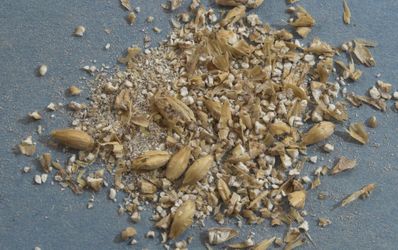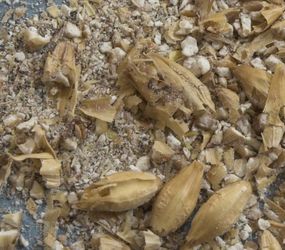CrushEval
When brewing all grain, the quality of the crush has a major impact on the brewhouse efficiency as well as the lautering process. In extreme cases, a poor crush can also lead to astringent off flavors.
The ideal crush for malt exposes all the endosperm as flour and grits and leaves the husks intact. But in practice this is difficult to achieve. In order to expose as much of the endosperm as possible, the malt has to be crushed very tightly which leaves most of the husk material shredded. This can lead to stuck sparges and astringent off-flavors. Conversely, when the malt is milled to loosely the husks are preserved better but a considerable amount of the endosperm remains unexposed which will result in a loss off efficiency. Because of this the brewer needs to find a good compromise for setting the grain mill spacing.
Contents
What to look for
- flour to grits ratio
- the more flour the higher the efficiency but also the chance for a slow lauter or stuck sparge
- average size of the husk pieces
- the larger the husk pieces, the better they will be able to suspend the grain bed during mashing and lautering. The latter helps with the run-off speed and prevents stuck sparges.
- small husk shreds
- small husk shreds can inhibit the run-off like flour and can be a significant contributor to astringent off-flavors.
- not or poorly crushed kernels
- If a kernel has not or only slightly been crushed, the mash may not be able to convert the starches and/or extract the sugars. This will lead to a lowered brewhouse efficiency.
- when endosperm remains in a crushed kernel, does it easily come out when the kernel is picked up?
- There is no problem with pieces of endosperm remaining in connection with the husks. As long as they come off easily or can easily be reached by the mash water.
Examples
2 roller mill dry
36mil / 0.92mm
|
This crush has been produced with a 2 roller mill (JSP Maltmill) at its factory setting of 36 mil / 0.92 mm. At this setting, which is fairly loose, no substantial husk shredding occurs while the endosperm is mostly ground into grits. Some of the endosperm is left behind in the husks. The low percentage of flour and well preserved husks will make for easy lautering. But even with well modified malts, the brewhouse efficiency will be average. |
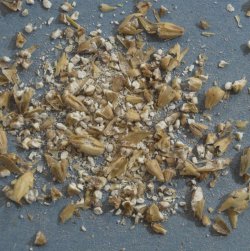 Malt crushed with 2 roller mill at factory setting (36 mil / 0.92 mm)(full size) |
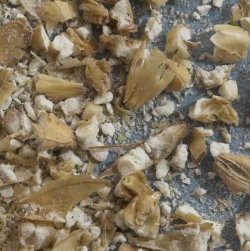 close-up of the same crush(full size) |
19 mil / 0.48mm
|
At a much tighter setting (19 mil / 0.48 mm), the same mill will produce considerably more flour and shredded husks. While the efficiency is significantly increased, the lauter may not run as easily and may even get stuck if the allowed run-off speed is to fast. As long as the mash and lauter pH are well below 5.8, no significant tanning extraction should be expected even though more of the husks have been shredded. The increased brewhouse efficiency makes this the crush of choice for many brewers. |
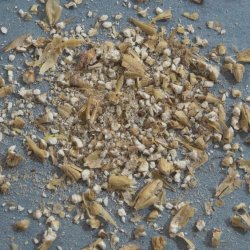 Malt crushed with 2 roller mill at a tight setting (19 mil / 0.48 mm)(full size) |
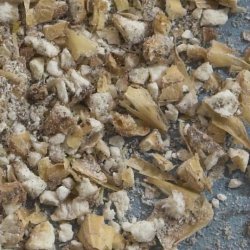 close-up of the same crush (full size) |
2 roller mill conditioned
In order to better preserve the husk during milling, Malt can be conditioned with moisture before milling. This makes the husk more pliable which results less small husk pieces even at a very tight mill setting.
36mil / 0.92mm
|
For this crush, the malt has been conditioned and the mill didn't tear the husks apart (only few of the husks were actually split in two halves) as it did with a dry crush. As a result some of the endosperm actually remained in the husks. But most of that endosperm actually falls right out of the husks when they are picked up and slightly rubbed between the fingers. The expected brewhouse efficiency should be similar to a dry crush at the same setting. In the close-up picture, the husk in the lower left corner even shows the indentation of the teeth of the malt mill roller. This illustrates how pliable the husks have become through the malt conditioning. |
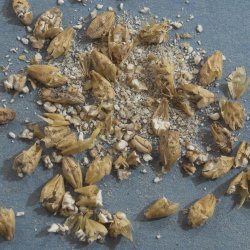 Conditioned malt crushed with 2 roller mill (JSP Maltmill) at factory setting (36 mil / 0.92 mm) (full size) |
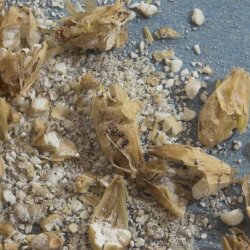 close-up of the same crush (full size) |
19mil / 0.48mm
|
Even at a tight setting of the mill, the husks of well conditioned malt remain intact while most of the endosperm is crushed into flour. There is a very small amount of husk shreds compared to a dry crush at the same setting which mitigates some of the astringency problem of a tight crush. Having most of the endosperm crushed to flour will boost the brewhouse efficiency but also impedes lautering. Some of that can be gained back by having the husks preserved. |
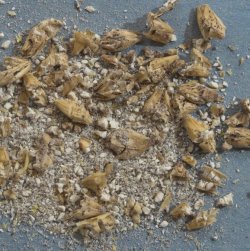 Conditioned malt crushed with 2 roller mill (JSP Maltmill) at a tight setting (19 mil / 0.48 mm) (full size) |
 close-up of the same crush (full size) |
examples of a poor crush
food processor
|
This "crush" has been produced with a food processor. It is not really a crush as a food processor has spinning blades which chop the malt rather than crushing it. The result are kernels that have been broken in a way that makes it difficult for the mash to reach the endosperm which will severely limit the brewhouse efficiency. Rather then preserving the husks, the spinning blades produced a lot of very small husks shreds that will impede the lautering speed and may also contribute astringent off-flavors. A food processor is considered an unsuitable substitute for crushing malt for brewing. The only exception would be huskless malts like wheat malt and Weyermann's Carafa Special malts. The latter are de-husked roasted malts. While the throughput of a food processor is not enough to process a batch of wheat malt it may work work well for the Carafa Special malts since only a small amount is generally used in a recipe. |
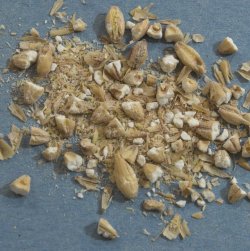 malt processed with a food processor (full size) |
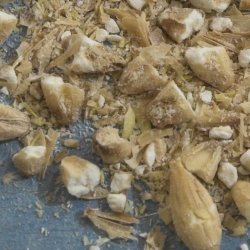 close-up of the same "crush" (full size) |
uneven crush
|
This uneven crush has been produced with a two roller malt mill (JSP Maltmill) set at 90 mil / 2.3mm on one end and 12 mil / 0.30 mm on the other end. It is a poor crush as it leaves some of the kernels untouched while others are completely crushed to dust (endosperm and husks). The efficiency is expected to suffer from the not or only partially crushed kernels and the lauter will suffer from the amounts of flour that has been produced. |
